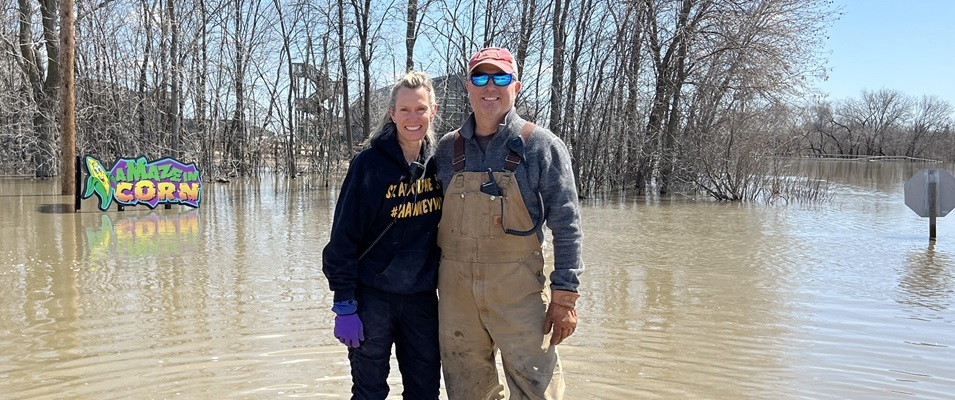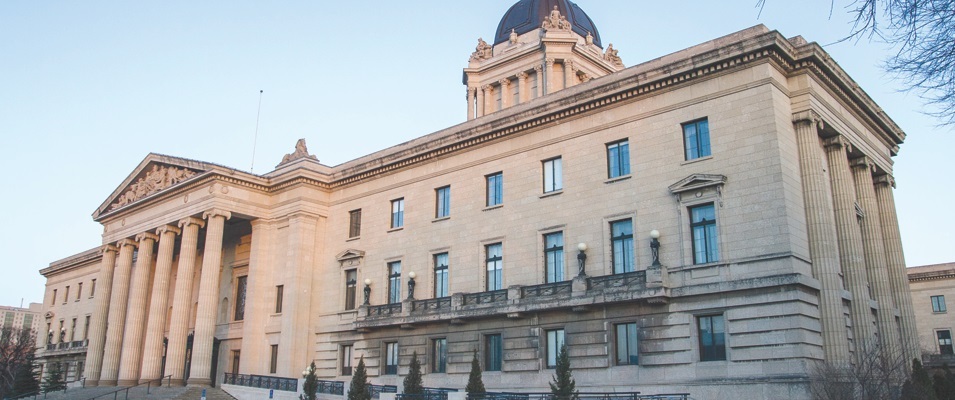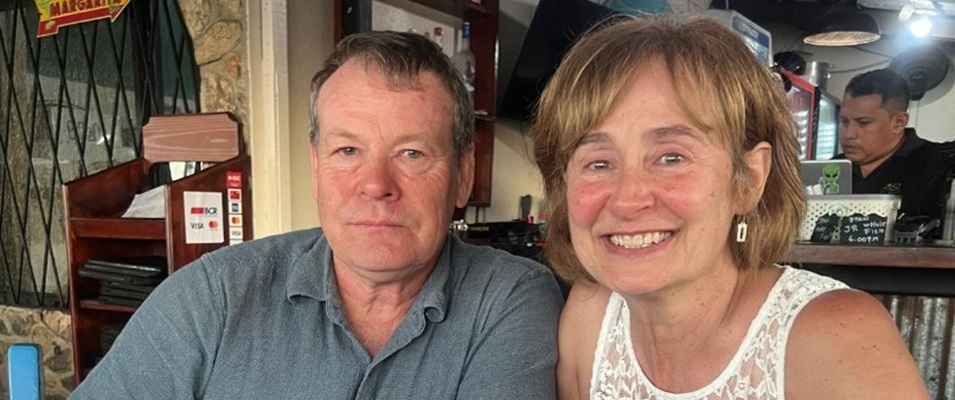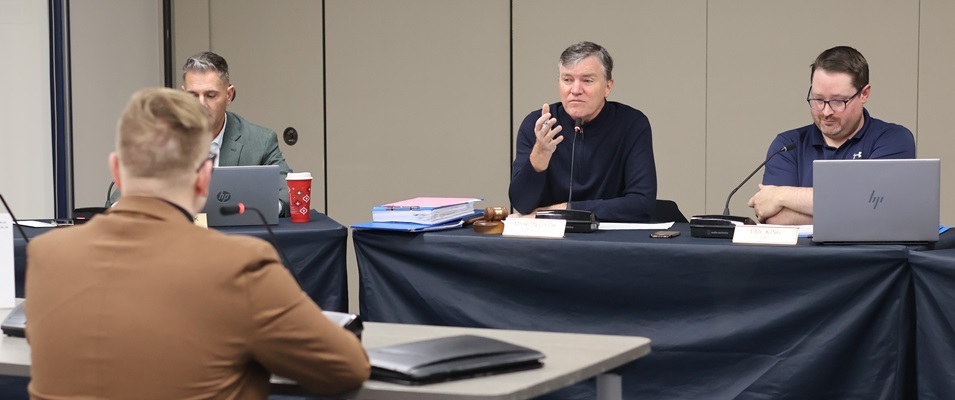
A Maze in Corn, an outdoor amusement centre north of St. Adolphe, has been involved in an ongoing legal tussle with the provincial government over its operation of the Red River Floodway.
The flooding occurred upstream of Winnipeg when the province decided to close the floodgates to prevent sewer backup in the city in the fall of 2019 when Manitoba received a record amount of rainfall.
That decision resulted in damage to A Maze in Corn’s parking area and Haunted Forest during peak season for the Halloween-themed attraction. According to business owner Clint Masse, the damage was estimated at $300,000 by the province’s own insurance adjustor.
The province denied this amount, however, and instead offered a payout of just $70,000.
Masse appealed to the provincial governing body in 2020 and was awarded an adjusted increase, raising the amount of compensation to $181,559.
Masse decided he couldn’t accept that and, having exhausted his appeal channels, made a legal claim against the province.
That case was heard in court on January 17, 2023. By the fall, the judge had decided in Masse’s favour.
However, Masse continues to wait for payment. While his argument won in court, the onus is once again back on the province to adjust the amount—at their own discretion.
Masse, who has farmed his property for most of his life, says something isn’t right about how the decisions were made at the provincial level that resulted in the loss of income for his business. He wants others in the Red River floodplain upstream of Winnipeg to know more about their rights when the province operates the Floodway.
The Process
When waters were rising in the fall of 2019, Masse was concerned… but not that the water would threaten his business. His land is located at the corner where the Seine River Diversion meets Highway 200 and then enters the Red River.
What did concern Masse was talk of the government operating the Floodway during the fall for the first time in its history.
Masse called the province to see about the likelihood of this and was told it wasn’t happening.
The next day, a neighbour called him to say that the floodgates were operating. By that evening, Masse’s parking lot and the Haunted Forest were underwater.
“Nobody wants a flood,” says Masse. “Nobody wants to clean up after a flood. The fact that we have a Haunted Forest, down in a ravine… it’s creepy. It’s a great place to be. For sure, it’s a low area. But no one expected it to flood that year.”
Masse notes that there was no public opposition at the municipal level when he first set out to open a business on his farmland. He knew it was risky to build an attraction on land that was desirable yet low.
He has looked for ways to position each attraction wisely, or to acquire flood protection.
“If I could move [the Haunted Forest], and we are talking about moving it to our back forest, if we could get flood protection we would,” he says. “But can you even qualify for flood insurance for a forest? It’s not easily done.”
Masse says the Haunted Forest is the crux of his business in the fall.
After use of the Floodway damaged his property, he watched the weather and waited, taking stock of what had happened. Most property owners living south of Winnipeg know that their properties will be sacrificed to save Winnipeg, even though it hurts when it has to happen.
As he waited, though, he suspected that in this case it did not have to happen.
“In hindsight, they never needed to raise the gates. They made a bad call,” says Masse. “There was risk. They analyze costs and damages. [Their report] said to expect $300,000 of losses south of Winnipeg and $100,000 in cost to operate the gates. So a total cost of $400,000 and the total benefit to Winnipeg would be $2.2 million… But they never got the rain that season to fulfill the forecast. There was no big deal. It was high, yes. It was for sure high. And they made the decision to store water here to save basements in Winnipeg that never would have flooded.”
Masse says that he isn’t unrealistic about what needs to be done to save the city from a natural flood. That is the function of the Floodway.
But the fact that the projected rainfall didn’t come and waters wouldn’t have continued to rise makes the situation emotionally charged.
Emotions aside, Masse says he just wants his income reimbursed, as he is owed under the provisions of The Red River Floodway Act.
“There’s all kinds of rules and regulations as to how to operate the floodgates,” he says. “They’re not meant to be operated out of season. The spring season is when they’re supposed to operate them. In addition to these set of rules, when [the province is] settling with a business directly affected by floodwaters, the Emergency Measures Organization says by law they have to hire an accredited business loss adjuster. They have to. It’s in the Act.”
But what’s not in the Act is a provision forcing the government to use their own insurance adjuster’s evaluation.
To aid the adjuster sent by the province after the 2019 flooding, Masse provided five years of income statements and suggested a five-year average as adequate compensation.
“The business loss representative said, ‘That works. That’s a good number.’ And we were willing to accept that. But then the province essentially said, ‘We’ll give you 30 cents on the dollar,’” says Masse. “But we were like, ‘It doesn’t say that in the Act. It says you cover all losses.’”
After exhausting the appeal process, Masse said he was left with no choice but to hire his own lawyer and pursue legal action. That process took more than a year.
While the result came down in his favour, it didn’t turn out as expected.
“The court of King’s Bench hears us based on err of law. So they rule on whether an error has been made, which they found there was. Then they decree the other party has to remedy that,” says Masse. “But they don’t do dollar amounts. They do law.”
In a situation like this, it means that the Masse is now entitled to appeal the matter again, and the province has to go back through its evaluation process to come up with a more reasonable figure.
“They did such a poor job with the assessment before, and we’re going to do this all over again? It doesn’t make a lot of sense,” says Masse. “The judge agreed with that. [The judge] said, ‘[The province] is liable for your legal fees going backward and all legal feels going forward.’ They structured that as the remedy they can apply. ‘If [the government] keeps fighting with you, they’re going to keep paying your bill.’ It’s a motivation to come to an agreement quicker.”
With the ball back in the province’s court, the Masses are tired, but they aren’t ready to give up. They say that if the province doesn’t come back to them with a reasonable figure, they will pursue a legal remedy a second time.
“I think if we fail again, we are going through the process gain. We could conceivably appear in front of the court again.”
Know Your Floodway
Most homeowners and business operators from Howden to Ste. Agathe know they live and work on a floodplain. But most don’t pay attention to the criteria the province must follow to operate the Floodway gates.
Masse says more property owners along the river need to make themselves aware of the criteria.
“What I’m finding is the people who work [in government], the people I worked with directly, they don’t know the Floodway Act either,” he says. “They’re telling you what is and what isn’t covered, making judgments and rulings on things, and they don’t even know the Act. The frontline people don’t know the Act, that it says they have to supply compensation for artificial flooding… I don’t think they had any clue what was required of them. It was on me to know.”
Masse says that The Red River Floodway Act is available online and is a pretty concise read. Manitoba Infrastructure also provides information on Flood Control Infrastructure and defines the four guidelines under which the Floodway would be operated.
Another tool provided online is a factsheet on the Post-Spring Non-Emergency Operation of the Red River Floodway, which provides helpful illustrations about how the Floodway works, along with dates and examples of when the Floodway has been operated outside of spring.
According to that factsheet: “Artificial flooding of some land and roads south of the floodway inlet control structure occurs when water levels out of the floodway channel inlet are raised above natural… In these instances, the Manitoba government provides compensation to individuals who experienced physical damages due to artificial flooding.”
Though written before 2019, the factsheet also states: “In all years of post spring operation… compensation was provided to affected residents for tangible damages (ex: damages to agricultural crops, roads, backyards and gardens).”
The provincial government has spent considerable time reviewing the Floodway and its operations on behalf of both the public and private interests. Of interest are the mounting arguments in support of increasing the frequency of operating the Floodway beyond the scope of spring flooding, which would enable water levels in Winnipeg to regulate more predictably, creating both recreational and commercial opportunities.
To allow increased operation of the Floodway, the province would be required to “undertake a variety of physical works, and upgrades to existing works, estimated to have a one-time cost of $55 million to $80 million. The increased floodway operating costs are estimated at up to $300,000 annually.”
The province would also need to compensate landowners for any damages caused by artificial flooding, as per the provisions of The Red River Floodway Act.
Non-emergency operation which increases artificial flooding upstream of the Floodway was studied in 2015 through multiple public focus groups and roundtable discussions, resulting in the Provincial Flood Control Infrastructure report.
Not surprisingly, it is well documented that residents upstream of the Floodway have a history of mistrust of the provincial government, and specifically the Manitoba Floodway Authority.
The Floodway was operated outside of spring four times prior to 2015. Applicants who were artificially flooded received compensation of $308,976 (among 21 applicants in 2002), $366,158 (among 61 applicants in 2004), $1,114,930 (among 120 applicants in 2005), and $76,017 (among 24 applicants in 2010).
In contrast to these figures, the most recent study into the question of whether to use the Floodway to reduce basement flooding in Winnipeg was conducted in 2013. It showed a benefit of $800,000 per year in reduced damages.
However, the study indicated that for any individual storm event, the benefits for the city and province could be in the tens of millions.
As Masse sees it, there is no doubt that the Red River Floodway is a good solution to a very difficult problem.
“It is a very flat plain that we live on and, yes, we need to manage the crazy amount of drainage the farmers are doing and keep the City of Winnipeg alive,” says Masse. “It’s a monster tool. The problem with a monster tool is there can be kind of a nuclear fallout.”
The environmental license for the Floodway stipulates a public review of the rules of operation not less than once every five years. As discussions surrounding the use of the Floodway continue, Masse would like to see more community members south of the city make themselves aware of the matter and participate more actively in future talks.
“They’re changing the Red River Floodway Act and I’m going to champion some watchdogging,” says Masse. “I’m hoping I’m doing some work for some guy who has not been squared up with on his behalf… Our company is a little bit bigger and if you’re a small market partner you won’t be able to [afford a legal battle] and you just have to roll over. If the province had followed the rules, they would’ve saved money… saved taxpayers money.”
The province did not respond to requests for comment to this story.




















